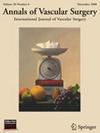开放浅静脉动脉化术挽救肢体。
IF 1.6
4区 医学
Q3 PERIPHERAL VASCULAR DISEASE
引用次数: 0
摘要
背景:慢性肢体威胁性缺血(CLTI)患者不适合常规血管内或手术血运重建术治疗大截肢。浅静脉动脉化(SVA)是另一种选择。没有病例报告成功超过2年。方法:回顾性分析2019-2023年由2名区域血管单元外科医生进行SVA手术的患者。主要终点是肢体保留。记录患者的表现、合并症和症状缓解情况。对患者进行临床随访,并行双工超声检查。结果:5例患者采用Lengua技术行开放下肢SVA。适应症为组织丢失4例,严重缺血性休息痛1例。中位年龄68岁(50-71岁),女性2例。中位随访时间为5个月(范围1-36),最长随访时间为3年。80%在技术上是成功的。残肢保留率为40%,静息疼痛缓解,伤口愈合。其他三人截肢,两人经胫骨,一人经股骨。一名患者移植物功能正常,但在灌注或疼痛方面没有改善,并要求截肢。结论:SVA为年轻、健康的CLTI患者提供了一种非常规但简单的保肢方法。描述了关键的技术考虑因素,先决条件的解剖和程序失败的原因。本文章由计算机程序翻译,如有差异,请以英文原文为准。
Open Superficial Venous Arterialization for Limb Salvage
Background
Patients with chronic limb threatening ischemia (CLTI) unsuitable for conventional endovascular or surgical revascularization are treated with major amputation. Superficial venous arterialization (SVA) presents an alternative option. No cases report success beyond 2 years.
Methods
Retrospective review of patients undergoing SVA between 2019 and 2023 by 2 surgeons in a regional vascular unit. The primary end point was limb salvage. Presentation, comorbidities, and symptom resolution were recorded. Patients were followed up clinically and with duplex ultrasound.
Results
Five patients underwent open lower limb SVA using the Lengua technique. Indications were tissue loss in 4 and severe ischemic rest pain in 1. Median age was 68 (range 50–71) years, 2 were female. Median follow-up was 5 months (range 1–36) with the longest ever reported follow-up at 3 years. Eighty percent were technically successful. Limb salvage rate was 40%, rest pain resolved and wounds healed in both. The other three had amputations – 2 transtibial and 1 transfemoral. Of these, one patient had a functioning graft but no benefit in perfusion or pain and requested amputation.
Conclusion
SVA offers an unconventional but simple option for limb salvage for younger, fitter patients with CLTI. Key technical considerations, prerequisite anatomy and reasons for failure are described.
求助全文
通过发布文献求助,成功后即可免费获取论文全文。
去求助
来源期刊
CiteScore
3.00
自引率
13.30%
发文量
603
审稿时长
50 days
期刊介绍:
Annals of Vascular Surgery, published eight times a year, invites original manuscripts reporting clinical and experimental work in vascular surgery for peer review. Articles may be submitted for the following sections of the journal:
Clinical Research (reports of clinical series, new drug or medical device trials)
Basic Science Research (new investigations, experimental work)
Case Reports (reports on a limited series of patients)
General Reviews (scholarly review of the existing literature on a relevant topic)
Developments in Endovascular and Endoscopic Surgery
Selected Techniques (technical maneuvers)
Historical Notes (interesting vignettes from the early days of vascular surgery)
Editorials/Correspondence

 求助内容:
求助内容: 应助结果提醒方式:
应助结果提醒方式:


